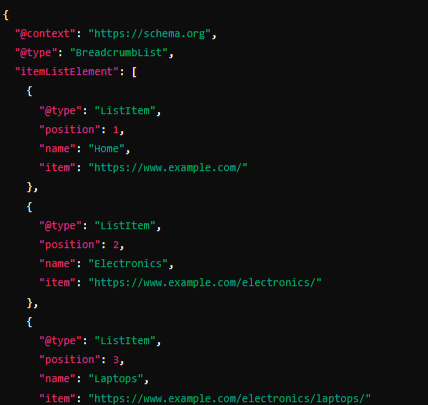
What Are Breadcrumbs & Why Do They Matter For Website SEO?
- By digitalretina
- No Comments
- Post Views: 253

In the complex landscape of website optimization, one often overlooked yet essential element is breadcrumbs. These tiny navigational aids play a significant role in enhancing both user experience and SEO performance. But what exactly are breadcrumbs, and why are they so crucial for your website’s SEO?
What Are Breadcrumbs?
Breadcrumbs are a type of secondary navigation that helps users trace their steps back through the hierarchy of a website. Think of them as a map, showing users the path they’ve taken from the homepage to their current location. Typically, breadcrumbs appear at the top of a webpage, formatted as a horizontal list of links separated by a “greater than” (>) symbol. For example: Home > Blog > SEO > What Are Breadcrumbs.
This simple yet effective feature is not just about guiding users—it also plays a pivotal role in breadcrumbs SEO, contributing to your website’s overall search engine optimization strategy.

Types of Breadcrumbs
There are three main types of breadcrumbs:
Hierarchy-Based Breadcrumbs are designed to show the structure of a website, giving users a clear idea of where they are within the overall site. For instance, on an e-commerce website, if you’re browsing gaming laptops, the breadcrumb trail might look like this: Home > Electronics > Laptops > Gaming Laptops. This trail helps users understand the relationship between the page they’re on and the rest of the site, making it easier to navigate back to broader categories.
Attribute-Based Breadcrumbs are particularly useful in e-commerce settings. These breadcrumbs display specific attributes or filters that users have applied to refine their search. For example, if a user is looking for a particular brand of laptop within a specific price range, the breadcrumb might read: Home > Electronics > Laptops > [Brand] > [Price Range]. This type of breadcrumb helps users keep track of their search criteria, making it easier to adjust or expand their search.
History-Based Breadcrumbs differ from the other types because they reflect the user’s actual navigation path rather than the site’s structure or search filters. These breadcrumbs show the series of pages and categories the user has visited to reach the current page. However, this type is less common as it can sometimes create a cluttered and confusing navigation experience, especially if the user has taken a complex path through the site.
Example 1: Basic Breadcrumbs Schema
This example represents a simple breadcrumb trail for a website.

Example 2: E-commerce Breadcrumbs Schema
This example represents breadcrumbs on an e-commerce site, showing the path to a specific product.

Why Breadcrumbs Matter for SEO?
Breadcrumbs are more than just a navigational aid; they are a powerful SEO tool. Here’s why:
SEO Benefits of Using Breadcrumbs
Improved User Experience: Breadcrumbs help users easily navigate back to higher-level pages, reducing bounce rates. A well-structured breadcrumb trail can keep users engaged with your site, leading to higher dwell times—an important metric for SEO.
Enhanced Crawlability: Search engines like Google use breadcrumbs to understand the structure of your website. By implementing breadcrumbs, you make it easier for search engines to crawl and index your site, improving your overall breadcrumbs SEO.
Rich Snippets: Breadcrumbs can appear in search engine results as part of rich snippets. This enhanced visibility in search results not only makes your listing more attractive but also increases click-through rates.
Lower Bounce Rates: When users can easily navigate your site, they’re more likely to stay longer. Lower bounce rates are an essential factor in SEO, and breadcrumbs can help achieve that by keeping visitors engaged.
Keyword Optimization: Incorporating relevant keywords into your breadcrumb trails can also boost your SEO efforts. For instance, if your breadcrumb includes the phrase “SEO Tips,” it can help that page rank better for related search queries.
Mobile Optimization: In the era of mobile-first indexing, breadcrumbs provide an easy-to-navigate structure for mobile users. This is crucial for maintaining a high mobile SEO score, especially with Google prioritizing mobile-friendly websites.
Internal Linking: Breadcrumbs serve as internal links, which are vital for distributing link equity across your site. This not only aids in SEO but also helps users discover more of your content.
Best Practices for Implementing Breadcrumbs
To fully leverage the benefits of breadcrumbs SEO, it’s essential to follow these best practices:
Consistency: Ensure that breadcrumbs are consistently placed across all pages of your website. This uniformity enhances user experience and makes it easier for search engines to crawl your site.
Clickable Links: Every item in the breadcrumb trail should be a clickable link, except for the current page. This not only aids navigation but also improves internal linking, which is beneficial for SEO.
Avoid Clutter: Keep breadcrumb trails simple and relevant. Overloading breadcrumbs with unnecessary links can confuse users and dilute their effectiveness.
Responsive Design: Make sure your breadcrumbs are mobile-friendly. Given the increasing number of mobile users, ensuring that breadcrumbs work well on smaller screens is critical for mobile SEO.
In conclusion
In summary, breadcrumbs are a vital yet often underutilized component of a comprehensive SEO strategy. By improving user navigation, enhancing search engine crawlability, and contributing to lower bounce rates, breadcrumbs significantly impact your website’s SEO performance. Whether you’re running an e-commerce site, a blog, or any other type of website, incorporating breadcrumbs can lead to tangible benefits in both user experience and search engine rankings.
Enhance your technical SEO with breadcrumbs—hire the top SEO Company in Noida today to elevate your website’s performance!
digitalretina

Brand Architect's Growth Engineer


Comprehensive Guide to PPC Strategies: How to Make the Most of Your Paid Advertising

